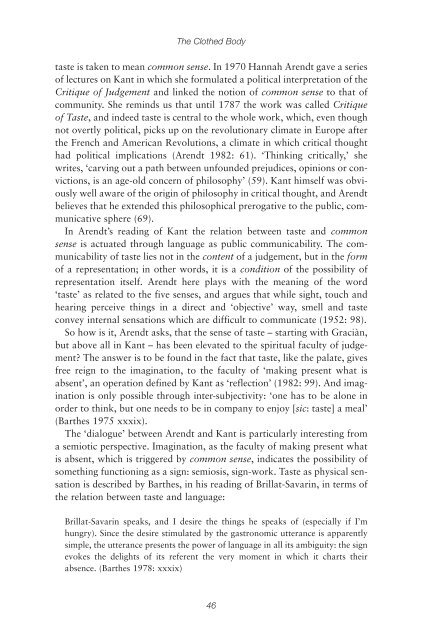Create successful ePaper yourself
Turn your PDF publications into a flip-book with our unique Google optimized e-Paper software.
<strong>The</strong> <strong>Clothed</strong> <strong>Body</strong><br />
taste is taken to mean common sense. In 1970 Hannah Arendt gave a series<br />
of lectures on Kant in which she formulated a political interpretation of the<br />
Critique of Judgement and linked the notion of common sense to that of<br />
community. She reminds us that until 1787 the work was called Critique<br />
of Taste, and indeed taste is central to the whole work, which, even though<br />
not overtly political, picks up on the revolutionary climate in Europe after<br />
the French and American Revolutions, a climate in which critical thought<br />
had political implications (Arendt 1982: 61). ‘Thinking critically,’ she<br />
writes, ‘carving out a path between unfounded prejudices, opinions or convictions,<br />
is an age-old concern of philosophy’ (59). Kant himself was obviously<br />
well aware of the origin of philosophy in critical thought, and Arendt<br />
believes that he extended this philosophical prerogative to the public, communicative<br />
sphere (69).<br />
In Arendt’s reading of Kant the relation between taste and common<br />
sense is actuated through language as public communicability. <strong>The</strong> communicability<br />
of taste lies not in the content of a judgement, but in the form<br />
of a representation; in other words, it is a condition of the possibility of<br />
representation itself. Arendt here plays with the meaning of the word<br />
‘taste’ as related to the five senses, and argues that while sight, touch and<br />
hearing perceive things in a direct and ‘objective’ way, smell and taste<br />
convey internal sensations which are difficult to communicate (1952: 98).<br />
So how is it, Arendt asks, that the sense of taste – starting with Graciàn,<br />
but above all in Kant – has been elevated to the spiritual faculty of judgement?<br />
<strong>The</strong> answer is to be found in the fact that taste, like the palate, gives<br />
free reign to the imagination, to the faculty of ‘making present what is<br />
absent’, an operation defined by Kant as ‘reflection’ (1982: 99). And imagination<br />
is only possible through inter-subjectivity: ‘one has to be alone in<br />
order to think, but one needs to be in company to enjoy [sic: taste] a meal’<br />
(Barthes 1975 xxxix).<br />
<strong>The</strong> ‘dialogue’ between Arendt and Kant is particularly interesting from<br />
a semiotic perspective. Imagination, as the faculty of making present what<br />
is absent, which is triggered by common sense, indicates the possibility of<br />
something functioning as a sign: semiosis, sign-work. Taste as physical sensation<br />
is described by Barthes, in his reading of Brillat-Savarin, in terms of<br />
the relation between taste and language:<br />
Brillat-Savarin speaks, and I desire the things he speaks of (especially if I’m<br />
hungry). Since the desire stimulated by the gastronomic utterance is apparently<br />
simple, the utterance presents the power of language in all its ambiguity: the sign<br />
evokes the delights of its referent the very moment in which it charts their<br />
absence. (Barthes 1978: xxxix)<br />
46

















